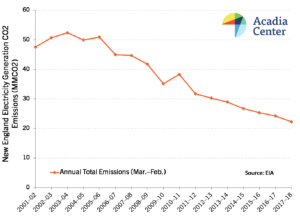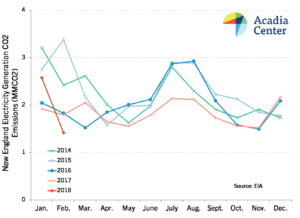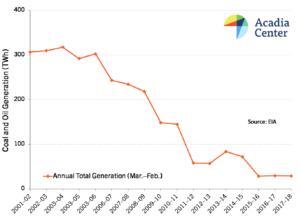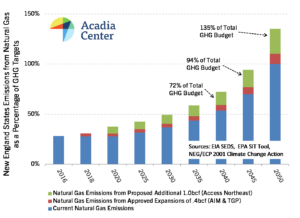Clearing the Air: Long-Term Trends and Context for New England’s Electricity Grid
Some entities and stakeholders have raised concerns about the environmental performance of New England’s electricity system during a particularly cold multi-week period in December 2017 and January 2018. Specifically, they have called attention to emissions due to the amount of oil and coal used for electricity generation during that time. Acadia Center takes these concerns very seriously and advocates strongly for reducing pollution that hurts public health and the climate in order to meet the region’s science-based requirements.
In addition, some of these stakeholders are advancing a specific proposal that they argue would solve the region’s emissions issues, a multi-billion-dollar electric ratepayer-funded investment in new natural gas pipeline capacity. Public investments in natural gas pipelines would have significant consequences for the region and the claimed benefits of such an investment should be scrutinized closely.
To provide perspective on the grid’s environmental performance this past winter and the impacts of a proposed major expansion of natural gas pipeline capacity, Acadia Center has developed a fact sheet which takes a comprehensive look at several different regional trends for greenhouse gas (GHG) emissions, electricity generation, and fuel consumption across all sectors. The results demonstrate that the selective statistics used by pipeline advocates are incomplete at best and significantly misleading at worst.
Policymakers in the region should not be misled by pipeline advocates and must consider a full set of options to ensure that New England continues to progress toward a clean, reliable, and affordable electricity system in the coming years. Eight charts on relevant issues are presented in the fact sheet, but the most important points are included here.
New England is making significant progress reducing GHG emissions from the electric sector over the long-term. New England GHG emissions from electricity generation from March 2017 through February 2018 were 53% lower than in 2001-02, 26% lower than in 2012-13, and 8% lower than in 2016-17. Progress reducing GHG emissions in the electric sector is undeniable, even accounting for emissions related to the cold snap in December 2017 and January 2018.
Figure 1 – Annual GHG Emissions (Mar. to Feb.) from Electricity
Generation in New England
The region has historically seen significant monthly variation in GHG emissions from electricity generation. While GHG emissions from electricity generation in New England were higher in December 2017 and January 2018 than some other months, seasonal and monthly variation in GHG emissions is normal. Monthly GHG emissions from electricity generation in New England are typically higher in hot summers and cold winters. January 2018 was the 10th highest month of GHG emissions dating back to the beginning of 2014, while February 2018 was the lowest in the 21st century.
Figure 2 – Monthly GHG Emissions from Electricity Generation
in New England
GHG emissions from electricity generation are falling in New England because of several drivers, including energy efficiency, increased renewables investment, and a major decrease in the amount of electricity generation from coal and oil. Annual electricity generated by coal and oil from March 2017 through February 2018 was 91% lower than the levels in 2001-02 and 49% lower than just five years ago in 2012-13.
Figure 3 – Annual Electricity Generation from Coal and Oil (Mar. to Feb.)
in New England
New England is rapidly approaching the limit of the GHG reduction strategy of replacing electricity generation from coal and oil with natural gas. As might be expected, coal and oil generation has been reduced in part through increases in natural gas generation. However, as a long-term strategy, shifting from one fossil fuel to another will not allow for the GHG emissions reductions the region needs to meet its science-based commitments.
GHG emissions from natural gas combustion across all sectors, including those from gas delivered through two recent regional pipeline expansions, will be an increasingly significant percentage of overall regional GHG emission limits over time. Looking at combustion emissions in isolation also understates the overall impact of emissions from natural gas because it ignores the significant GHG emissions during extraction and delivery. Adding a major new regional pipeline would only exacerbate this issue, potentially increasing combustion emissions from natural gas to 49% of the overall regional GHG emissions target in 2030, and that would rise to 72% in 2040, and 135% in 2050.
Figure 4 – Natural Gas Combustion Emissions in New England from All Sectors Versus Overall Regional GHG Emissions Requirements
Of course, emissions are not the only important policy consideration for the successful operation of New England’s grid. Other serious considerations are reliability and consumer costs. Some stakeholders have argued that there is a medium-term reliability risk, which could lead to rolling blackouts or other harms. However, a recent report from Synapse Energy Economics demonstrates that, with reasonable expectations for growth in demand for electricity and natural gas and accounting for planned investments in renewables and transmission for clean energy, the risk of major reliability issues is close to zero. Keeping on this path will take some effort but should be achievable.
On the consumer costs side, using hard-earned ratepayer dollars for major new natural gas pipelines would not have any impact on electricity prices until construction is finished, which could be in 2022 or even later. Furthermore, there are good reasons to think that purported consumer benefits would not outweigh the guaranteed costs that ratepayers would have to pay. Major investments are currently being planned for offshore wind and new transmission lines for clean energy that would come online in the same timeframe as a pipeline, and these investments undercut many of the alleged benefits of a pipeline. Additional pipeline capacity would also increase the chances of exporting natural gas out of New England, which would drive up natural gas prices.
In the shorter term, many other available policy options can help improve the reliability of New England’s grid and reduce costs, while simultaneously lowering emissions. This year, ISO-NE is implementing “pay-for-performance” market reforms, which provide additional incentives to generators to respond during times of high demand and high prices. Additional investments in energy efficiency for natural gas and electricity, fixing leaks in the natural gas distribution system, advanced energy storage, local renewables, and grid modernization will start to help right away with energy prices and reliability, while simultaneously advancing the region’s long-term emissions requirements.
The usefulness of using natural gas as a “bridge” over the last two decades is at an end and the region needs to avoid further long-term public investments in fossil fuels. New England’s economic and environmental future depends upon building a clean, reliable, and affordable modern energy system. Acadia Center’s EnergyVision 2030 shows a path to meet economy-wide GHG emissions reductions of 45% from 1990 levels by 2030 using market-ready technologies, with no additional natural gas pipeline capacity needed. It’s time to move forward with a smart portfolio of investments to benefit consumers, create well-paying local jobs, improve public health, and lower the risks of climate change.






















